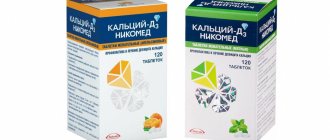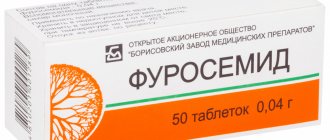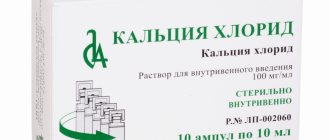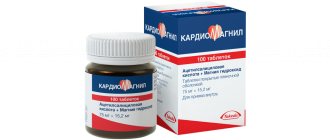Pharmacodynamics and pharmacokinetics
This remedy is often referred to as Vitamin B5 or Pantothenic acid . You need to know what it is and why it is needed to understand the principle of action of the drug. This substance is very common in nature. pantothenic acid is very common in foods; liver, egg yolk, peas, kidneys, fish roe, and yeast are rich in it.
In the body, it is part of the acetylation coenzyme , which influences the processes of acetylation and oxidation. In addition, pantothenic acid (vitamin B5) takes part in metabolic processes and the synthesis of acetylcholine . It is found in significant quantities in the adrenal cortex and activates the formation of corticosteroids .
The body's daily need for pantothenic acid is about 11 mg. With significant physical activity, as well as during breastfeeding , the need for it increases to 20 mg. It is produced in the body by E. coli , so it is not necessary to consume foods that contain pantothenic acid ; vitamin deficiency is not observed due to its deficiency.
of pantothenic acid is used as a medicine . It is obtained synthetically. Pantothenic acid preparations are used for various pathological conditions that are associated with metabolic .
PANTOTHENIC ACID (VITAMIN B5)
GENERAL INFORMATION
Vitamin B5 ( pantothenic acid ) is a water-soluble vitamin, so it does not stay in the body for long and requires constant replenishment of its reserves. Vitamin B5 in its pure form was isolated in 1939 from the liver of mammals. Like other B vitamins, pantothenic acid is an active substance necessary for every living organism. In 1940, it was possible to elucidate the chemical structure of pantothenic acid and carry out its synthesis in the form of a calcium salt (calcium pantothenate). Pantothenic acid formula C9H1705N.
Pantothenic acid is widely distributed in natural foods of animal and plant origin, and therefore its name comes from the Greek word "pantos", which means "omnipresent". Pantothenic acid is found in all tissues of animals and plants, mainly in bound form, but is also found in free form.
The empirical formula of the compound is C9H17N O5
Despite the ubiquity of pantothenic acid in nature, a person may experience a deficiency of the substance. The abundance of white bread, semi-finished products, chips, canned foods and the lack of fresh vegetables, fruits, and meat products in the diet leads to the fact that vitamin B5 practically does not enter the body, as a result of which hypovitaminosis occurs.
Due to a deficiency of the compound, metabolism primarily suffers, digestion worsens, and the immune-protective function decreases. A person becomes susceptible to inflammatory processes - ARVI. This is due to the fact that Pantothenic acid and coenzyme A synthesized with its participation are involved in many processes: in the oxidation of fatty acids and carbohydrates, in the synthesis of amino acids, fatty acids, ketones, cholesterol, phospholipids, steroid hormones, neurotransmitters (for example, acetylcholine) and antibodies
In order for pantothenic acid to be preserved in maximum quantities in dishes, you should avoid eating frozen, canned foods, foods with a long shelf life that contain vinegar essence, and also cook in the most gentle mode: over low heat, extremely quickly under a closed lid.
Indications for use
The use of this remedy is indicated for polyneuritis , paresthesia , eczema , neuralgia , photodermatoses , lupus erythematosus . In addition, it can be prescribed for catarrh of the upper respiratory tract, various allergic reactions , trophic ulcers , burns , toxicosis of pregnancy, bronchial asthma , gastric and duodenal ulcers , pityriasis rosea , bronchitis , intestinal atony after surgery, poisoning with streptomycin arsenic preparations . Recently, this remedy has also been included in the complex therapy of withdrawal syndrome in the treatment of alcoholism .
To determine what Pantothenic Acid may be used for in each specific case, you should consult your doctor.
Recommended dosage
You should take the tablets in the first half of the day with plenty of water. In case of postoperative absence of intestinal smooth muscle tone, 250 mg is administered every 6 hours. In other cases, calcium D pantothenate is taken 1-2 times a day. Recommended daily dosages for use:
- children under 3 years old - 50-100 mg;
- children from 3 to 14 years old - 100-200 mg;
- children over 14 years of age and adults - 200-400 mg;
- pregnant women - 200-500 mg;
- nursing - 300-700 mg.
When treating alcohol intoxication and withdrawal syndrome, the daily dosage is 500-1000 mg. The instructions for the calcium pantothenate preparation indicate that for the treatment of dermatitis the daily dosage can be increased to 1500 mg. The exact dose for each individual case is calculated by the attending physician, based on the patient’s condition, age and severity of the disease.
Instructions for use of Calcium Pantothenate (Method and dosage)
Pantothenic acid is administered intramuscularly or intravenously .
For adult patients, a dosage of 0.1-0.2 g is indicated. Injections are given 2-4 times every day. Children 1-3 years old can be given 0.005–0.1 g of medication at a time, from 3 to 14 years old – 0.1–0.2 g can be administered. Injections are given 2 times daily.
For the treatment of dermatological diseases , the drug is used in a daily dosage of 1.5 g for adult patients and 0.2-0.6 g for children 2-3 times daily.
In the case of intestinal atony after surgical interventions, adult patients are administered 0.3 g every 6 hours. Depending on the characteristics of the disease, therapy can last up to two months.
Instructions for use of Calcium Pantothenate parenterally states that it should be administered to adult patients 1-2 times daily in a dosage of 0.2-0.4 g. For children under 3 years of age, a single dose of 0.05-0.1 g is indicated, and for children from 3 to 14 years the medicine is administered 1-2 times/day in a dosage of 0.1-0.2 g.
If it is necessary to correct adverse reactions of anti-tuberculosis pantothenic acid preparations are taken throughout the entire course of therapy.
In case of withdrawal syndrome in people suffering from alcoholism , 0.5 g of 10% solution per day is administered intramuscularly or intravenously. And for alcoholic delirium, a 10% solution is used. Dosage – 1 g. The course of application is designed for 10 days.
The drug solution can also be used in the form of aerosols. This is done in case of diseases of the respiratory system. Then dissolve 0.2 g of the drug in 5 ml of water and obtain a 4% solution. It is inhaled for 10-15 minutes every day. The course of application is designed for 7-8 days.
Use of tablets
Tablets are taken before meals. The dosage for children from one to 3 years old is half a tablet per day, from 3 to 14 years old - one or two tablets twice a day. From 14 years of age you should take one or two tablets up to four times a day.
HYPOVITAMINOSIS OF VITAMIN B5
Let's consider the sequence of manifestation of symptoms of pantothenic acid deficiency.
- Fatigue, increased fatigue. The reason for the appearance of these reactions is that calcium pantothenate is consumed at the highest rate in the muscles, and the lack of the compound in the muscles leads to a decrease in the performance of the body as a whole.
- Nervous disorders. First of all, hypovitaminosis leads to sleep disturbances. Further, as a result of chronic lack of sleep, the functioning of the central nervous system deteriorates, psycho-emotional stress occurs, burning in the toes, and depression develops.
- Headaches, muscle pain. Athletes especially often experience pain in their muscles when they are deficient in B5. This phenomenon occurs as a result of metabolic disturbances, which lead to complete utilization of lactic acid. As a result, the athlete experiences muscle pain and feels tired, like after a hard marathon.
- Deterioration of the condition of the skin (the appearance of dermatitis, seborrhea, eczema), hair loss, slower growth and brittleness of the nail plate.
- Digestive disorders. In the first stages, the characteristic symptoms of pantothenic acid hypovitaminosis in the human body are lack of appetite and nausea; if the lack of organic compounds is not corrected, chronic indigestion of food, constant occurrence of diarrhea, constipation, peptic ulcer, gastritis and cholecystitis develop.
- “Burning” attacks of pain in the legs at night (not cramps), accompanied by sharp redness of the skin in the area of the feet.
- Metabolic disorders that lead to hormonal imbalance in women. These problems are especially dangerous during menopause, as they can cause not only sudden changes in pressure, but also ataxia.
- Slowing (rarely stopping) growth in adolescents, weight loss.
- Exhaustion caused by indigestion and constant fatigue.
- Weakening of the immune system, susceptibility to acute respiratory diseases.
- Kidney dysfunction associated with improper production of various hormones. As a rule, problems with the urinary organs occur extremely rarely, in advanced stages of hypovitaminosis.
- Diseases of the heart and blood vessels caused by impaired synthesis of glucocorticoids and cholesterol. Clogged arteries lead to the development of atherosclerosis.
- Visual impairment (in some cases, blindness).
During World War II, “burning feet” syndrome was widespread among prisoners of war in Japanese camps, which resulted from severe disruption of a healthy diet. In addition, pantothenic acid deficiency in soldiers was accompanied by impaired mental activity, central scotoma, pallor of the optic nerves, and blurred vision. At the same time, the inclusion of 30 milligrams of a mixture of B vitamins in the diet eliminated these phenomena and relieved patients from glossitis, stomatitis, diseases of the cornea, sclera, and conjunctivitis.
FACTORS THAT CAUSE B5 DEFICIENCY
Let's consider the reasons why the body begins to experience a deficiency of the substance.
- Long-term use of sulfonamides and antibiotics. These drugs block the synthesis of active derivatives of vitamin B5. As a result, even with an abundance of pantothenic acid in food, the body may experience a deficiency of the compound.
- Lack of proteins and fats in the daily menu. Taking proteins and triglycerides speeds up and facilitates the absorption of calcium pantothenate. Therefore, for men, women, and children who follow vegetarianism and a raw food diet, they should carefully approach the formation of their diet in order to prevent the compound from not being absorbed.
- Lack of vitamins B1, B2, C, which are actively involved in the synthesis of pantheine and coenzyme-A.
- Digestive disorders (deterioration of food absorption) - malabsorption syndrome. In case of development of this disease, food with a high content of useful organic compounds passes through the body in transit (non-absorption of nutrients from food).
Pantothenic acid deficiency leads to diseases of the blood, skin, nails, duodenal ulcers, and hypoglycemia.
Considering the fact that vitamin B5 is included in many products of plant and animal origin, deficiency of the compound in the human body is a rare phenomenon, which, in most cases, occurs due to an unbalanced diet or under the influence of factors that contribute to neutralization or non-absorption useful substance.
Hypervitaminosis B5 is more common. Excess of the compound is non-toxic to humans. A single injection of 500 milligrams of calcium pantothenate intravenously does not cause side effects from the body. In rare cases, dehydration, insomnia, agitation, increased heart rate, headache, and nausea are observed.
THE BODY'S NEED FOR PANTOTHENIC ACID
Physiological needs for pantothenic acid according to Methodological recommendations MP 2.3.1.2432-08 on the norms of physiological needs for energy and nutrients for various groups of the population of the Russian Federation:
- There is no upper permissible consumption level.
- The physiological requirement for adults is 5 mg/day (introduced for the first time).
- The physiological need for children is from 1.0 to 5.0 mg/day (introduced for the first time).
Table 1. Recommended daily intake of pantothenic acid depending on age (mg):
| Age | Daily requirement for vitamin B5, (mg) | |
| Infants | 0 - 3 months | 1 |
| 4 - 6 months | 1,5 | |
| 7 - 12 months | 2 | |
| Children from 1 year to 11 years | 1 — 3 | 2,5 |
| 3 — 7 | 3 | |
| 7 — 11 | 3 | |
| Men (boys, young men) | 11 — 14 | 3,5 |
| 14 — 18 | 5 | |
| > 18 | 5 | |
| Women (girls, girls) | 11 — 14 | 3,5 |
| 14 — 18 | 4 | |
| > 18 | 5 | |
| Pregnant | 6 | |
| Nursing | 7 |
Additional intake of calcium pantothenate is prescribed in the following cases:
- for infectious diseases;
- consumption of low-calorie foods;
- intense physical activity;
- in the postoperative period;
- during times of stress;
- people of retirement age (over 55 years old);
- for polyneuritis, neuralgia, bronchial asthma, disorders of the central nervous system, diseases of the gastrointestinal tract;
- to improve the condition of nails, hair, skin;
- during the period of antibiotic use.
Only the attending physician can determine the required daily dose of the compound.
In case of progression of dermatological diseases, one of the fundamental treatment drugs is pantothenic acid, which is prescribed in a dose significantly higher than the daily norm for a healthy person (up to 1500 milligrams per day).
To combat acne, the dosage of B5 increases to an impressive amount - up to 10,000 units per day.
Interaction
This remedy should not be used earlier than 12 hours after using Proserin and Ditilin .
Calcium Pantothenate improves the energy supply of myocardial contractile function and the therapeutic effect of cardiac glycosides . In addition, it reduces the toxic effects of aminoglycosides , sulfonamides , drugs with arsenic and streptomycin antibiotics .
All about vitamin B5 (pantothenic acid, calcium pantothenate)
Calcium salt of D-(+)-pantothenic acid – calcium pantothenate
Description
Pantothenic acid gets its name from the Greek "pantothene", meaning "everywhere", due to its extremely wide distribution. Pantothenic acid, entering the body, is converted into pantethine, which is part of coenzyme A, which plays an important role in the processes of oxidation and acetylation. Coenzyme A is one of the few substances in the body that is involved in the metabolism of proteins, fats, and carbohydrates. Vitamin B5 is necessary for the metabolism of fats, carbohydrates, amino acids, the synthesis of vital fatty acids, cholesterol, histamine, acetylcholine, and hemoglobin. Pantothenic acid is sensitive to heat; almost 50% of the vitamin is lost during heat treatment.
Sources
| vegetable | animals | synthesis in the body |
| Peas, yeast, hazelnuts, green leafy vegetables, buckwheat and oatmeal, cauliflower. | Liver, kidneys, heart, chicken, egg yolk, milk, fish roe. | Produced in significant quantities by E. coli. |
Pantothenic acid [D(+)a, g-dioxy-b, b-dimethylbutyryl-b-alanine] is widely distributed in nature.
The content of vitamin B5 (pantothenic acid) in Argo dietary supplements: Beauty Natural, Longevity, Bogatyrskoe salad oil, Poly Vitabeas (vitamins), Multi-Complex, Nettle extract, Cocktail “Grace”, “Energy”, Nutricons
Action
The most important property of vitamin B5 is its ability to stimulate the production of adrenal hormones - glucocorticoids, which makes it a powerful tool for treating diseases such as arthritis, colitis, allergies and heart disease. It plays an important role in the formation of antibodies, promotes the absorption of other vitamins, and also takes part in the synthesis of neurotransmitters. Pantothenic acid is involved in fatty acid metabolism. It normalizes lipid metabolism and activates redox processes in the body. Pantothenic acid has a significant hypolipidemic effect, apparently due to inhibition of the biosynthesis of the main classes of lipids that form low and very low density lipoproteins in the liver.
Daily requirement
Recommended daily intake of vitamin B5 by age in the United States (mg)
| Infants | Children | Men | Women | ||||||||||||||
| Age | 0-1/2 | 1/2-1 | 1-3 | 4-6 | 7-10 | 11-14 | 15-18 | 19-24 | 25-50 | > 51 | 11-14 | 15-18 | 19-24 | 25-50 | > 51 | pregnant women | nursing |
| USA | 2 | 3 | 3-4 | 3-4 | 4-5 | 4-7 | 4-7 | 4-7 | 4-7 | 4-7 | 4-7 | 4-7 | 4-7 | 4-7 | 4-7 | 4-7 | 4-7 |
The need for vitamin B5 increases with heavy physical activity, as well as in breastfeeding women.
Symptoms of hypovitaminosis
Vitamin deficiency can be caused by low levels of protein, fat, vitamin C, B vitamins in food, diseases of the small intestine with malabsorption syndrome, as well as long-term use of many antibiotics and sulfonamides. Symptoms of hypovitaminosis:
- fatigue
- depression
- sleep disorder
- increased fatigue
- headache
- nausea
- muscle pain
- burning, tingling, numbness of toes
- burning, excruciating pain in the lower extremities, mainly at night
- redness of the skin of the feet
- dyspeptic disorders
- duodenal ulcers
With pantothenic deficiency, the body's resistance to infection decreases, and acute respiratory diseases often occur.
Indications
Calcium pantothenate is used as a medicine. Indications for use are:
- various pathological conditions associated with metabolic disorders
- polyneuritis, neuralgia, paresthesia
- eczema
- bronchitis (acute and chronic), bronchial asthma
- allergic reactions (dermatitis, hay fever, etc.)
- trophic ulcers, burns
- toxicosis of pregnant women
- hyperthyroidism
- tuberculosis
- circulatory failure
- chronic liver diseases
- chronic pancreatitis
- diseases of the gastrointestinal tract of non-infectious nature (gastroduodenitis, etc.)
- hypomotor intestinal dyskinesia
In surgery, calcium pantothenate is used to eliminate intestinal atony after operations on the gastrointestinal tract. Calcium pantothenate is used in the complex therapy of withdrawal syndrome in patients with alcoholism. Vitamin B5 has shown its effectiveness in large doses (up to 10 g per day) in the treatment of acne (acne).
Dosages
Calcium pantothenate is used orally, intramuscularly or intravenously. Orally, adults are prescribed 0.1-0.2 g 2-4 times a day; children from 1 to 3 years old - 0.005-0.1 g, from 3 to 14 years old - 0.1-0.2 g 2 times a day. The daily dose for adults is 0.4-0.8 g, for children - 0.1-0.4 g. In dermatology, vitamin B5 is used in large doses: in adults 1.5 g per day, in children 0. 1-0.3 g 2-3 times a day.
Safety
Calcium pantothenate is well tolerated. When taken orally, dyspeptic symptoms are possible; with intramuscular injections - pain.
Interaction
Calcium pantothenate increases the effectiveness of cardiac glycosides. Reduces the toxic effect of streptomycin and other anti-tuberculosis drugs. Vitamin B5 is necessary for the normal absorption and metabolism of folic acid.
Analogs of Calcium Pantothenate
Level 4 ATC code matches:
Medobiotin
Volvit
Nicotinamide
Alpha Tocopherol Acetate
Riboflavin
Pyridoxine Hydrochloride
Pyridoxine
Vitrum Vitamin E
Calcium Pantothenate analogues are very widespread, but none of them should be replaced independently, without consulting a specialist.
Well-known analogues of Calcium Pantothenate are Aminalon , Neuro-norm , Noobut , Noozam , Noofen and Vasavital . These drugs are prescribed for various diseases of the nervous system. In addition, analogues such as Olatropil , Pantogam , Picamilon , Semax , Phenotropil , Ceregin Evrysam , Omaron , Pantocalcin , Pramistar , Phezam , Ceregin , Evrysam , etc. are also popular.
Combined preparations of calcium and vitamin D3: who to recommend and how to argue?
It is obvious that products containing colecalciferol can be considered the drugs of choice for the treatment and prevention of vitamin D insufficiency and deficiency: they are included in domestic and foreign clinical recommendations. But in what cases is it appropriate to recommend combined preparations of vitamin D and calcium to visitors and what should their attention be paid to?
From effect to indications
As you know, the main function of vitamin D is to regulate calcium-phosphorus metabolism. In the form of active metabolites, it takes part in the process of calcium absorption in the intestine and its excretion by the kidneys. In the presence of sufficient vitamin D, calcium absorption in the intestine is optimal. If the need for the “sunshine vitamin” is not compensated, calcium absorption decreases. Due to the low level of ionized calcium in the blood, the synthesis of parathyroid hormone is stimulated, which works to increase serum calcium, in particular, it stimulates the leaching of calcium and phosphorus from the bones. This chain of changes leads to a natural result of vitamin D deficiency - a decrease in calcium levels, changes in bone mineralization and, as a consequence, the development of rickets and osteoporosis.
Of course, there is no need to educate clients about these difficulties. Suffice it to say that hypovitaminosis D is associated with a negative calcium balance and decreased bone mineralization. These complications can be prevented by complex preparations of vitamin D and calcium, which potentiate the effect of each component. Their main task and leading indication is the prevention and treatment (as part of complex therapy) of osteoporosis, which usually develops in old age.
- It is appropriate to give preference to colecalciferol and calcium preparations when asking for drugs for the prevention and treatment of osteoporosis in women during or after menopause, as well as for strengthening bones in old age.
Dosage and course of treatment
According to the recommendations of the Russian Association of Endocrinologists, the preventive dose of vitamin D for 18-50 years old is 600-800 IU per day, and for those over 50 years old - 800-1000 IU per day. The dosage of calcium aimed at preventing bone density can be up to 2000 mg per day. In addition, existing recommendations indicate that for better absorption, a single dose of calcium should not exceed 600 mg.
Medicines - sources of vitamin D and calcium have balanced formulas and contain 200 or 400 IU of colecalciferol and 500 mg of calcium. All of them are taken 1 tablet 1-2 times a day, and the average dosage of the components supplied with them does not exceed the recommended daily doses.
- When dispensing drugs of this group to clients, it is appropriate to note that the dosage of the drugs is selected in such a way as to compensate for the body’s needs and to prevent excess vitamin and calcium. Therefore, you cannot independently increase the dose indicated in the instructions - this can lead to an increase in the level of calcium in the blood, which can impair the functioning of the kidneys and blood vessels.
Along with the dosage, it is important to follow the course of treatment recommended in the instructions. On average, it ranges from 4 to 6 weeks, but it may vary slightly for different drugs.
- When consulting a client, it should be emphasized that colecalciferol and vitamin D 3 for a long time without consulting a doctor .
Use during pregnancy, lactation, and childhood
Almost all drugs containing colecalciferol and vitamin D3 can be used during pregnancy and breastfeeding. However, we must not forget that hypercalcemia during pregnancy can adversely affect the development of the fetus. Therefore, the drugs themselves, and their dosage and course of treatment, should be selected by the attending physician.
Children's age is also not a contraindication to the use of the combination of colecalciferol + calcium. But, again, the doctor must decide on prescribing these drugs to children and select the dose and duration of therapy.
What else should you warn the client about?
When dispensing combined preparations of vitamin D and calcium, it is important to take into account that calcium salts reduce the pH of gastric juice, slow down gastric motility and, moreover, easily form complexes with a number of substances, which can interfere with the absorption of drugs. Therefore, it is better to take medications containing calcium separately from other medications - on average 2 hours before or 4-6 hours after, unless otherwise indicated.
In addition, you should remember the most common drug interactions with drugs from the following pharmacological groups:
- Antibiotics of the tetracycline group - when taken simultaneously with calcium supplements, the absorption of antibiotics may decrease. Therefore, tetracycline antibiotics should be taken at least 2 hours before or 4–6 hours after taking calcium supplements.
- Bisphosphonates – when taken simultaneously with colecalciferol and calcium, the absorption of bisphosphonates is reduced. Therefore, the time interval between the use of bisphosphonates and calcium supplements should be at least half an hour, and it is better to take them at different times of the day.
NB! Bisphosphonates are first-line drugs for the treatment of osteoporosis and can be part of a comprehensive treatment regimen along with vitamin D and calcium supplements.
- Cardiac glycosides and calcium channel blockers - when taken together with calcium supplements and/or vitamin D, it is recommended to monitor the level of calcium in the blood to avoid the development of hypercalcemia. The latter increases the risk of fatal arrhythmias in patients receiving digoxin and reduces the effectiveness of calcium channel blockers.
- Thiazide diuretics - reduce calcium excretion, which is associated with an increased risk of hypercalcemia. It is important for patients receiving these drugs to monitor serum calcium levels regularly.
We have listed only the most common drug interactions; their full list is much more extensive. And in order to prevent them, it is important to persistently recommend that the client take any medications separately from calcium and vitamin D preparations. And to make it easier for you to navigate the fairly large assortment, we have prepared a table for downloading, in which we have collected currently registered medications containing colecalciferol and calcium with dosages of active ingredients and indications. We hope that this information will help you easily and quickly select a drug for appropriate requests.
We answer questions live on VKontakte: https://vk.com/pharmznanie
You can discuss the latest news with all your Russian colleagues in chats:
Telegram: https://tglink.ru/pharmorden
VKontakte: https://vk.me/join/AJQ1d_D2XxaDy9IdzL0e6EqH
To leave a comment on this article, you need to register or log in.
Interested in the article? You can find out even more in the section Working in a pharmacy









